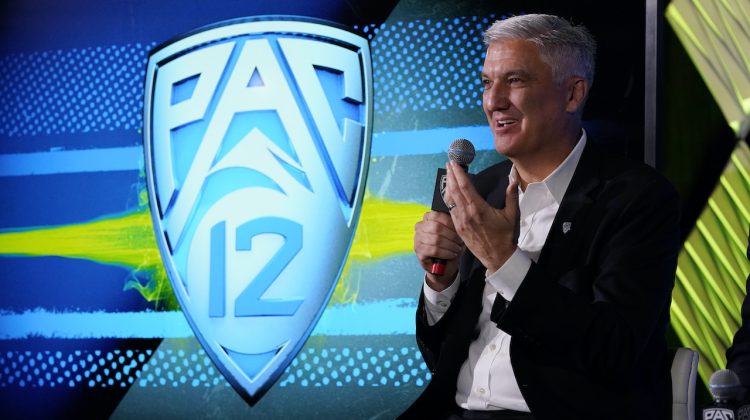Pac-12 commissioner George Kliavkoff has said little about the future of the conference since the thunderbolt from Los Angeles on June 30.
He spoke publicly at a preseason media event in late July, then went radio silent for nearly two months before making an appearance on the ‘Canzano and Wilner’ podcast in mid-September. Then came another month away from the spotlight.
Kliavkoff re-emerged this week for appearances at Pac-12 men’s and women’s basketball festivities in San Francisco, including question-and-answer sessions with reporters.
Naturally, he was asked about the ongoing media rights negotiations. While careful not to offer specifics, two comments caused jaws to drop and eyebrows to elevate across the college sports landscape.
— Regarding the looming revenue gap between the reconfigured Pac-12 and the 16-team Big Ten and SEC behemoths, Kliavkoff said:
“We’re going to do a media rights deal here in the near future, which will close the gap between us and the Big Ten and the SEC. That’s a first step. Eventually we’ll catch those guys. It will take a couple of steps.”
— Regarding the possibility that UCLA’s move to the Big Ten will be a money-loser for the Bruins (on a net basis), Kliavkoff said:
“We believe between the travel and the coaches’ salaries and some of the other expenses you incur when you join the Big Ten, the small delta in the media rights deal will be more than offset. We stand by those numbers.”
So the commissioner of the Pac-12 believes the conference will eliminate a $30 million-to-$40 million (per school) annual revenue disparity and that UCLA’s move into the richest conference is, in fact, a financial miscalculation
Is he of sound mind? Have Kliavkoff’s marbles joined the Big Ten, too?
Fortunately, the Hotline’s array of content offerings includes a translation app. While we don’t necessarily agree with Kliavkoff, especially in regard to the revenue gap, we’ll attempt to explain how he arrived at those conclusions.
Conveniently enough, the explanation for both statements is rooted in the same place: The true value of the Big Ten’s new media rights contract.
When the agreement with Fox, CBS and NBC was announced on Aug. 18, published reports indicated the seven-year deal was valued at “more than $1 billion per year” and “nearly $8 billion over seven years” and everything in between.
That’s not what we’ve heard, folks.
In recent weeks, multiple industry sources have told the Hotline the initial reports carried inflated numbers and that $1 billion per year is the maximum value of the agreement (as a 16-school conference).
We suspect Pac-12 headquarters has heard the same thing.
And if that $1 billion figure is accurate, then the deal is worth an average of $62.5 million per campus per year across the seven years — not the $70 million-to-$75 million per school figures that have been tossed about in media reports and on social platforms.
It could be years before we know the true value, and contracts can be structured with all sorts of clauses and stipulations. But our guess is that Kliavkoff is using $62.5 million as the benchmark.
And if that’s his assumption, both statements start to make a teeny-tiny bit more sense.
Here’s how:
— The revenue gap.
Projections are a tad difficult on this topic because of uncertainty over the annual media revenue for the SEC once Texas and Oklahoma join the conference in 2025. And we believe the SEC will end up ahead of the Big Ten in the media rights race in the second half of the decade.
But is the low end — the $62.5 million for the Big Ten schools — even possible for the Pac-12?
Only if the conference signs a contract this fall that exceeds valuation estimates … and then does it again in a few years.
Our strong suspicion (previously reported on the Hotline) is that Kliavkoff intends to secure a five-year media rights contract. It would start in July 2024 and conclude in June 2029, one year before the Big Ten’s new deal expires.
That would allow the Pac-12 to feed twice at the media rights trough before the Big Ten and the SEC gorge again.
Could the second deal allow the Pac-12 to pull even given the soaring value of media rights for college football?
Even with the potential for the conference to add markets through expansion — perhaps San Diego (San Diego State) and Dallas (SMU) — we’re deeply skeptical.
But that’s the scenario, the only scenario, for getting close to the SEC and Big Ten in annual media rights revenue.
It seemingly would only be close to the Big Ten for one year, because that conference is due to start a new contract cycle the following summer.
And by then, the entire Power Five structure could implode.
— UCLA’s finances
When assessing the profitability of the Bruins’ move, many fans mistakenly compare expectations for the Pac-12’s annual revenue without the L.A. schools ($30-something million) to what UCLA is projected to reap in the Big Ten ($70-something million).
In reality, the correct comparison is UCLA’s revenue if it stayed in the Pac-12 to the paychecks expected in the Big Ten.
Here, Kliavkoff is using a valuation figure for the Pac-12 that includes the Los Angeles market.
Our guess is that he believes the conference would generate about $50 million annually if the Bruins stayed put — or $12.5 million less than UCLA stands to make from the Big Ten’s whisper number ($62.5 million).
And that $12.5 million would be largely or entirely offset by the added travel and administrative costs required for Big Ten membership.
Now, that logic doesn’t include postseason revenue, and the Bruins stand to receive more from the Big Ten than the Pac-12 because the former will undoubtedly have more College Football Playoff berths and March Madness units.
But if the focus is limited to media revenue from regular-season broadcasts, that’s the answer, folks:
Kliavkoff believes the Pac-12’s financial ceiling with UCLA is higher than the public recognizes … and that the Big Ten’s revenue reality with the L.A. schools is lower than published reports suggest.
Is he right about UCLA? Is his plan to “catch” the Big Ten and SEC reasonable?
On both fronts, there’s a good chance we’ll never know.
Support the Hotline: Receive three months of unlimited access for just 99 cents. Yep, that’s 99 cents for 90 days, with the option to cancel anytime. Details are here, and thanks for your support.
*** Send suggestions, comments and tips (confidentiality guaranteed) to pac12hotline@bayareanewsgroup.com or call 408-920-5716
*** Follow me on Twitter: @WilnerHotline
*** Pac-12 Hotline is not endorsed or sponsored by the Pac-12 Conference, and the views expressed herein do not necessarily reflect the views of the Conference.
Related posts:

(AP Photo/Marcio Jose Sanchez)
Wilner Hotline: Pac-12 North coming down to Battle of Oregon Kliavkoff says Big 12 “scared,” UCLA in tough spot with Big Ten move, Pac-12 exploring expansion and big tech interested in media rights
Kliavkoff says Big 12 “scared,” UCLA in tough spot with Big Ten move, Pac-12 exploring expansion and big tech interested in media rights
 Hotline mailbag: Kliavkoff’s grant-of-rights challenge, UCLA’s fate, Big 12 fans, streaming options, SDSU’s position and more
Hotline mailbag: Kliavkoff’s grant-of-rights challenge, UCLA’s fate, Big 12 fans, streaming options, SDSU’s position and more
 Business of Sports – Former Fox Sports president skeptical that Big Ten move would make sense for Washington, Oregon, Bay Area schools
Business of Sports – Former Fox Sports president skeptical that Big Ten move would make sense for Washington, Oregon, Bay Area schools

